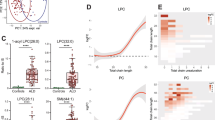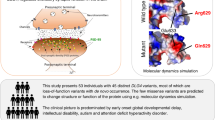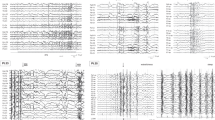Abstract
X-linked adrenoleukodystrophy (X-ALD) is caused by a defect in the gene ABCD1, which maps to Xq28 and codes for a peroxisomal membrane protein that is a member of the ATP-binding cassette transporter superfamily. X-ALD is panethnic and affects approximately 1:20,000 males. Phenotypes include the rapidly progressive childhood, adolescent, and adult cerebral forms; adrenomyeloneuropathy, which presents as slowly progressive paraparesis in adults; and Addison disease without neurologic manifestations. These phenotypes are frequently misdiagnosed, respectively, as attention-deficit hyperactivity disorder (ADHD), multiple sclerosis, or idiopathic Addison disease. Approximately 50% of female carriers develop a spastic paraparesis secondary to myelopathic changes similar to adrenomyeloneuropathy. Assays of very long chain fatty acids in plasma, cultured chorion villus cells and amniocytes, and mutation analysis permit presymptomatic and prenatal diagnosis, as well as carrier identification. The timely use of these assays is essential for genetic counseling and therapy. Early diagnosis and treatment can prevent overt Addison disease, and significantly reduce the frequency of the severe childhood cerebral phenotype. A promising new method for mass newborn screening has been developed, the implementation of which will have a profound effect on the diagnosis and therapy of X-ALD.
Key Points
-
X-linked adrenoleukodystrophy (X-ALD) is characterized by elevated levels of very long chain fatty acids, which occur secondary to defects in peroxisome β-oxidation associated with mutations in the ABCD1 gene
-
X-ALD is characterized by variable phenotypes affecting the nervous system and the adrenal glands
-
Treatments have focused on lowering levels of very long chain fatty acids using the compound Lorenzo's oil, and hematopoetic stem cell therapy
-
Newborn screening is in development, and this might alter the detection, monitoring and treatment of X-ALD
This is a preview of subscription content, access via your institution
Access options
Subscribe to this journal
Receive 12 print issues and online access
$209.00 per year
only $17.42 per issue
Buy this article
- Purchase on SpringerLink
- Instant access to full article PDF
Prices may be subject to local taxes which are calculated during checkout

Similar content being viewed by others
References
Bezman L et al. (2001) Adrenoleukodystrophy: incidence, new mutation rate, and results of extended family screening. Ann Neurol 49: 512–517
Mosser J et al. (1993) Putative X-linked adrenoleukodystrophy gene shares unexpected homology with ABC transporters. Nature 361: 726–730
Kemp S et al. (2005) Elongation of very long-chain fatty acids is enhanced in X-linked adrenoleukodystrophy. Mol Genet Metab 84: 144–151
Igarashi M et al. (1976) Fatty acid abnormality in adrenoleukodystrophy. J Neurochem 26: 851–860
Theda C et al. (1992) Phospholipids in X-linked adrenoleukodystrophy white matter: fatty acid abnormalities before the onset of demyelination. J Neurol Sci 110: 195–204
Paintlia AS et al. (2003) Correlation of very long chain fatty acid accumulation and inflammatory disease progression in childhood ALD: implications for potential therapies. Neurobiol Dis 14: 425–439
Reinecke CJ et al. (1985) The correlation between biochemical and histopathological findings in adrenoleukodystrophy. J Neurol Sci 70: 21–38
Igarashi M et al. (1976) Brain gangliosides in adrenoleukodystrophy. J Neurochem 27: 327–328
Bizzozero OA et al. (1991) Fatty acid composition of human myelin proteolipid protein in peroxisomal disorders. J Neurochem 56: 872–878
Moser AB et al. (1999) Plasma very long chain fatty acids in 3,000 peroxisome disease patients and 29,000 controls. Ann Neurol 45: 100–110
Tsuji S et al. (1981) Abnormality of long-chain fatty acids in erythrocyte membrane sphingomyelin from patients with adrenoleukodystrophy. J Neurochem 36: 1046–1049
Moser HW et al. (1980) Adrenoleukodystrophy: elevated C26 fatty acid in cultured skin fibroblasts. Ann Neurol 7: 542–549
Moser HW et al. (1982) The prenatal diagnosis of adrenoleukodystrophy. Demonstration of increased hexacosanoic acid levels in cultured amniocytes and fetal adrenal gland. Pediatr Res 16: 172–175
Singh I et al. (1984) Adrenoleukodystrophy: impaired oxidation of very long chain fatty acids in white blood cells, cultured skin fibroblasts, and amniocytes. Pediatr Res 18: 286–290
Poulos A et al. (1986) Accumulation and defective beta-oxidation of very long chain fatty acids in Zellweger's syndrome, adrenoleukodystrophy and Refsum's disease variants. Clin Genet 29: 397–408
Kemp S et al. (1998) Gene redundancy and pharmacological gene therapy: implications for X- linked adrenoleukodystrophy. Nat Med 4: 1261–1268
Wanders RJ et al. (1987) Peroxisomal very long-chain fatty acid beta-oxidation in human skin fibroblasts: activity in Zellweger syndrome and other peroxisomal disorders. Clin Chim Acta 166: 255–263
Singh I et al. (1984) Lignoceric acid is oxidized in the peroxisome: implications for the Zellweger cerebro-hepato-renal syndrome and adrenoleukodystrophy. Proc Natl Acad Sci USA 81: 4203–4207
Hashimoto T (1996) Peroxisomal beta-oxidation: enzymology and molecular biology. Ann NY Acad Sci 804: 86–98
Wanders RJ (2004) Peroxisomes, lipid metabolism, and peroxisomal disorders. Mol Genet Metab 83: 16–27
Uchiyama A et al. (1996) Molecular cloning of cDNA encoding rat very long-chain acyl-CoA synthetase. J Biol Chem 271: 30360–30365
Lazo O et al. (1988) Peroxisomal lignoceroyl-CoA ligase deficiency in childhood adrenoleukodystrophy and adrenomyeloneuropathy. Proc Natl Acad Sci USA 85: 7647–7651
Wanders RJ et al. (1988) X-linked adrenoleukodystrophy: identification of the primary defect at the level of a deficient peroxisomal very long chain fatty acyl-CoA synthetase using a newly developed method for the isolation of peroxisomes from skin fibroblasts. J Inherit Metab Dis 11 (Suppl 2): 173–177
McGuinness MC et al. (2003) Role of ALDP (ABCD1) and mitochondria in X-linked adrenoleukodystrophy. Mol Cell Biol 23: 744–753
Oezen I et al. (2005) Accumulation of very long-chain fatty acids does not affect mitochondrial function in adrenoleukodystrophy protein deficiency. Hum Mol Genet 14: 1127–1137
Tsuji S et al. (1981) Increased synthesis of hexacosanoic acid (C26:0) by cultured skin fibroblasts from patients with adrenoleukodystrophy (ALD) and adrenomyeloneuropathy (AMN). Biochem J (Tokyo) 90: 1233–1236
Ho JK et al. (1995) Interactions of a very long chain fatty acid with model membranes and serum albumin. Implications for the pathogenesis of adrenoleukodystrophy. J Clin Invest 96: 1455–1463
Choi JK et al. (2002) Interactions of very long-chain saturated fatty acids with serum albumin. J Lipid Res 43: 1000–1010
Migeon BR et al. (1981) Adrenoleukodystrophy: evidence for X linkage, inactivation, and selection favoring the mutant allele in heterozygous cells. Proc Natl Acad Sci USA 78: 5066–5070
Dean M et al. (2001) The human ATP-binding cassette (ABC) transporter superfamily. J Lipid Res 42: 1007–1017
Netik A et al. (1999) Adrenoleukodystrophy-related protein can compensate functionally for adrenoleukodystrophy protein deficiency (X-ALD): implications for therapy. Hum Mol Genet 8: 907–913
Pujol A et al. (2004) Functional overlap between ABCD1 (ALD) and ABCD2 (ALDR) transporters: a therapeutic target for X-adrenoleukodystrophy. Hum Mol Genet 13: 2997–3006
Troffer-Charlier N et al. (1998) Mirror expression of adrenoleukodystrophy and adrenoleukodystrophy related genes in mouse tissues and human cell lines. Eur J Cell Biol 75: 254–264
X-linked Adrenoleukodystrophy Database [www.x-ald.nl]
Kemp S et al. (2001) ABCD1 mutations and the X-linked adrenoleukodystrophy mutation database: role in diagnosis and clinical correlations. Hum Mutat 18: 499–515
Mosser J et al. (1994) The gene responsible for adrenoleukodystrophy encodes a peroxisomal membrane protein. Hum Mol Genet 3: 265–271
Braiterman LT et al. (1999) Peroxisomal very long chain fatty acid beta-oxidation activity is determined by the level of adrenodeukodystrophy protein (ALDP) expression. Mol Genet Metab 66: 91–99
Wanders RJ et al. (2006) The peroxisomal ABC transporter family. Pflugers Arch [doi: 10.1007/s00424-006-0142-x]
Moser HW et al. (2001) X-linked adrenoleukodystrophy. In The Metabolic and Molecular Bases of Inherited Disease, edn 8, 3257–3301 (Eds Scriver CR et al.) New York: McGraw-Hill
Moser HW et al. (1992) Adrenoleukodystrophy: phenotypic variability and implications for therapy. J Inherit Metab Dis 15: 645–664
Smith KD et al. (1999) X-linked adrenoleukodystrophy: genes, mutations, and phenotypes. Neurochem Res 24: 521–535
Schaumburg HH et al. (1975) Adrenoleukodystrophy. A clinical and pathological study of 17 cases. Arch Neurol 32: 577–591
Ito M et al. (2001) Potential environmental and host participants in the early white matter lesion of adreno-leukodystrophy: morphologic evidence for CD8 cytotoxic T cells, cytolysis of oligodendrocytes, and CD1-mediated lipid antigen presentation. J Neuropathol Exp Neurol 60: 1004–1019
Powers JM et al. (1992) The inflammatory myelinopathy of adreno-leukodystrophy: cells, effector molecules, and pathogenetic implications. J Neuropathol Exp Neurol 51: 630–643
Powers JM et al. (2005) Adreno-leukodystrophy: oxidative stress of mice and men. J Neuropathol Exp Neurol 64: 1067–1079
Budka H et al. (1976) Spastic paraplegia associated with Addison's disease: adult variant of adreno-leukodystrophy. J Neurol 213: 237–250
Griffin JW et al. (1977) Adrenomyeloneuropathy: a probable variant of adrenoleukodystrophy. I. Clinical and endocrinologic aspects. Neurology 27: 1107–1113
Powers JM et al. (2000) Adrenomyeloneuropathy: a neuropathologic review featuring its noninflammatory myelopathy. J Neuropathol Exp Neurol 59: 89–102
Powers JM et al. (2001) The dorsal root ganglia in adrenomyeloneuropathy: neuronal atrophy and abnormal mitochondria. J Neuropathol Exp Neurol 60: 493–501
Dubey P et al. (2005) Spectroscopic evidence of cerebral axonopathy in patients with 'pure' adrenomyeloneuropathy. Neurology 64: 304–310
Chaudhry V et al. (1996) Nerve conduction studies in adrenomyeloneuropathy. J Neurol Neurosurg Psychiatry 61: 181–185
van Geel BM et al. (1996) Peripheral nerve abnormalities in adrenomyeloneuropathy: a clinical and electrodiagnostic study. Neurology 46: 112–118
van Geel BM et al. (2001) Evolution of phenotypes in adult male patients with X-linked adrenoleukodystrophy. Ann Neurol 49: 186–194
Case records of the Massachusetts General Hospital (1979) Weekly clinicopathological exercises. Case 18-1979. N Engl J Med 300: 1037–1045
Jorge P et al. (1994) X-linked adrenoleukodystrophy in patients with idiopathic Addison disease. Eur J Pediatr 153: 594–597
Powers JM et al. (1980) A correlative study of the adrenal cortex in adreno-leukodystrophy—evidence for a fatal intoxication with very long chain saturated fatty acids. Invest Cell Pathol 3: 353–376
Boehm CD et al. (1999) Accurate DNA-based diagnostic and carrier testing for X-linked adrenoleukodystrophy. Mol Genet Metab 66: 128–136
Cox C et al. (2006) Cognitive evaluation of neurologically asymptomatic boys with X-linked adrenoleukodystrophy. Arch Neurol 63: 69–73
Moser HW et al. (1991) Clinical aspects of adrenoleukodystrophy and adrenomyeloneuropathy. Dev Neurosci 13: 254–261
Restuccia D et al. (1997) Neurophysiological abnormalities in adrenoleukodystrophy carriers. Evidence of different degrees of central nervous system involvement. Brain 120: 1139–1148
Fatemi A et al. (2003) MRI and proton MRSI in women heterozygous for X-linked adrenoleukodystrophy. Neurology 60: 1301–1307
el-Deiry SS et al. (1997) Assessment of adrenal function in women heterozygous for adrenoleukodystrophy. J Clin Endocrinol Metab 82: 856–860
Powers JM et al. (1987) Pathologic findings in adrenoleukodystrophy heterozygotes. Arch Pathol Lab Med 111: 151–153
Di Biase A et al. (2004) Free radical release in C6 glial cells enriched in hexacosanoic acid: implication for X-linked adrenoleukodystrophy pathogenesis. Neurochem Int 44: 215–221
Vargas CR et al. (2004) Evidence that oxidative stress is increased in patients with X-linked adrenoleukodystrophy. Biochim Biophys Acta 1688: 26–32
Gilg AG et al. (2000) Inducible nitric oxide synthase in the central nervous system of patients with X-adrenoleukodystrophy. J Neuropathol Exp Neurol 59: 1063–1069
Moody DB et al. (1999) The molecular basis of CD1-mediated presentation of lipid antigens. Immunol Rev 172: 285–296
Linnebank M et al. (2006) Methionine metabolism and phenotypic variability in X-linked adrenoleukodystrophy. Neurology 66: 442–443
Moser HW et al. (2005) Adrenoleukodystrophy: new approaches to a neurodegenerative disease. JAMA 294: 3131–3134
Valianpour F et al. (2003) Analysis of very long chain fatty acids using electrospray ionization mass spectrometry. Mol Genet Metab 79: 189–196
Moser HW et al. (1983) Identification of female carriers of adrenoleukodystrophy. J Pediatr 103: 54–59
Moser AB and Moser HW (1999) The prenatal diagnosis of X-linked adrenoleukodystrophy. Prenat Diagn 19: 46–48
Kumar AJ et al. (1987) Adrenoleukodystrophy: correlating MR imaging with CT. Radiology 165: 497–504
Loes DJ et al. (2003) Analysis of MRI patterns aids prediction of progression in X-linked adrenoleukodystrophy. Neurology 61: 369–374
Eichler FS et al. (2002) Proton MR spectroscopic imaging predicts lesion progression on MRI in X-linked adrenoleukodystrophy. Neurology 58: 901–907
Oz G et al. (2005) Assessment of adrenoleukodystrophy lesions by high field MRS in non-sedated pediatric patients. Neurology 64: 434–441
Dubey P et al. (2005) Diffusion tensor-based imaging reveals occult abnormalities in adrenomyeloneuropathy. Ann Neurol 58: 758–766
Fatemi A et al. (2005) Magnetization transfer MRI demonstrates spinal cord pathology in adrenomyeloneuropathy. Neurology 64: 1739–1745
McGovern MM et al. (2003) Biochemical effect of intravenous arginine butyrate in X-linked adrenoleukodystrophy. J Pediatr 142: 709–713
Pai GS et al. (2000) Lovastatin therapy for X-linked adrenoleukodystrophy: clinical and biochemical observations on 12 patients. Mol Genet Metab 69: 312–322
Fourcade S et al. (2003) Thyroid hormone induction of the adrenoleukodystrophy-related gene (ABCD2). Mol Pharmacol 63: 1296–1303
Benhamida S et al. (2003) Transduced CD34+ cells from adrenoleukodystrophy patients with HIV-derived vector mediate long-term engraftment of NOD/SCID mice. Mol Ther 7: 317–324
Dubey P et al. (2005) Adrenal insufficiency in asymptomatic adrenoleukodystrophy patients identified by very long chain fatty acid screening. J Pediatr 146: 528–532
Zhang LX et al. (2003) Clinical and electrophysiological improvement of adrenomyeloneuropathy with steroid treatment. J Neurol Neurosurg Psychiatry 74: 822–823
Rizzo WB et al. (1989) Dietary erucic acid therapy for X-linked adrenoleukodystrophy. Neurology 39: 1415–1422
van Geel BM et al. (1999) Progression of abnormalities in adrenomyeloneuropathy and neurologically asymptomatic X-linked adrenoleukodystrophy despite treatment with 'Lorenzo's oil'. J Neurol Neurosurg Psychiatry 67: 290–299
Uziel G et al. (1991) Experience on therapy of adrenoleukodystrophy and adrenomyeloneuropathy. Dev Neurosci 13: 274–279
Aubourg P et al. (1993) A two-year trial of oleic and erucic acids ('Lorenzo's oil') as treatment for adrenomyeloneuropathy. N Engl J Med 329: 745–752
Rizzo WB et al. (1990) X-linked adrenoleukodystrophy: biochemical and clinical efficacy of dietary erucic acid therapy. In Adrenoleukodystrophy and other Peroxisomal Disorders, 149–162 (Eds Uziel G et al.) Amsterdam: Excerpta Medica
Moser HW et al. (2005) Follow-up of 89 Lorenzo's Oil treated asymptomatic adrenoleukodystrophy patients. Arch Neurol 62: 1073–1080
Peters C et al. (2004) Cerebral X-linked adrenoleukodystrophy: the international hematopoietic cell transplantation experience from 1982 to 1999. Blood 104: 881–888
Koehler W and Sokolowski P (2005) Clinical phenotypes, diagnosis and treatment of adulthood X-linked adrenoleukodystrophy. In Understanding and Treating Adrenoleukodystrophy. Present State and Future Perspectives, 28–60 (Eds Berger J et al.) SPS Verlagsgessellschaft: Heilbronn
Aubourg P et al. (1990) Reversal of early neurologic and neuroradiologic manifestations of X-linked adrenoleukodystrophy by bone marrow transplantation. N Engl J Med 322: 1860–1866
Shapiro E et al. (2000) Long-term effect of bone-marrow transplantation for childhood-onset cerebral X-linked adrenoleukodystrophy. Lancet 356: 713–718
Hickey WF and Kimura H (1988) Perivascular microglial cells of the CNS are bone marrow-derived and present antigen in vivo. Science 239: 290–292
Unger ER et al. (1993) Male donor-derived cells in the brains of female sex-mismatched bone marrow transplant recipients: a Y-chromosome specific in situ hybridization study. J Neuropathol Exp Neurol 52: 460–470
Nowaczyk MJ et al. (1997) Immunoablation does not delay the neurologic progression of X-linked adrenoleukodystrophy. J Pediatr 131: 453–455
Mahmood A et al. (2005) Evaluating survival in nontransplanted boys with the cerebral phenotype of X-linked adrenoleukodystrophy [abstract]. Ann Neurol 58 (Suppl 9): 52a
Loes DJ et al. (1994) Adrenoleukodystrophy: a scoring method for brain MR observations. AJNR Am J Neuroradiol 15: 1761–1766
Hubbard WC et al. (2006) Combined liquid chromatography–tandem mass spectrometry as an analytical method for high throughput screening for X-linked adrenoleukodystrophy and other peroxisomal disorders: preliminary findings. Mol Genet Metab 89: 185–187
Acknowledgements
This work was supported by the Johns Hopkins University School of Medicine General Clinical Research Center grant MO-1-R00052 from the National Center for Research Resources/ National Institutes of Health, Bethesda, MD, and grants HD 39276 and HD 10981 from the National Institutes of Health, Bethesda, MD.
Author information
Authors and Affiliations
Corresponding author
Ethics declarations
Competing interests
The authors declare no competing financial interests.
Rights and permissions
About this article
Cite this article
Moser, H., Mahmood, A. & Raymond, G. X-linked adrenoleukodystrophy. Nat Rev Neurol 3, 140–151 (2007). https://doi.org/10.1038/ncpneuro0421
Received:
Accepted:
Issue Date:
DOI: https://doi.org/10.1038/ncpneuro0421
This article is cited by
-
Abnormal activation of MAPKs pathways and inhibition of autophagy in a group of patients with Zellweger spectrum disorders and X-linked adrenoleukodystrophy
Orphanet Journal of Rare Diseases (2023)
-
Hematopoietic stem-cell gene therapy is associated with restored white matter microvascular function in cerebral adrenoleukodystrophy
Nature Communications (2023)
-
Initial frontal lobe involvement in adult cerebral X-linked adrenoleukodystrophy
Acta Neurologica Belgica (2023)
-
Adrenoleucodistrofia: l’evoluzione della terapia
L'Endocrinologo (2022)
-
Defining diagnostic cutoffs in neurological patients for serum very long chain fatty acids (VLCFA) in genetically confirmed X-Adrenoleukodystrophy
Scientific Reports (2020)




